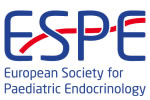ESPE2021 ePoster Category 1 Adrenal A (10 abstracts)
Backdoor Pathway hormones and 11-oxygenated Androgens are elevated in Patients with 21-hydroxylase deficiency
Alexandra Kulle 1 , Tabea Lamprecht 1 , Francisca Pinto 1 , Kristina Wulf 1 , Nadine Hornig 1 , Thomas Reinehr 2 & Paul-Martin Holterhus 1
1University Hospital Schleswig-Holstein, Campus Kiel, Children’s Hospital, Department of Paediatrics, Division of Pediatric Endocrinology and Diabetes, Kiel, Germany; 2University of Witten/Herdecke, Vestische Hospital for Children and Adolescents, Datteln, Germany
Background: Patients with 21-Hydroxylase deficiency (21OHD) present increased levels of cytochrome P450 21-hydroxylase substrates, like progesterone and 17α-hydroxyprogesterone. Previous studies could show that these hormones are involved in the production of androgens via the backdoor pathway. As a second source of androgens, 11-oxyandrogens derived from the human adrenal glands are recognized as being major androgens. Specifically, 11-oxyandrogens are active androgens in many patients with 21-hydroxylase deficiency.
Methods and patients: We developed an LC-MS/MS method for the determination of 5α-pregnane-3α,17α-diol-20-one (pdiol), androstanediol, androsterone, dihydrotestosterone (DHT), androstenedione, testosterone, 17-hydroxyprogesterone (17OHP), 11-ketotestosterone (11KT), 11-ketoandrostenedione (11A4), 11-ketodihydrotestosterone (11KDHT) for plasma and serum. We compared the steroid profiles of 56 treatment-naïve 21-OHD patients (25 males, 31 females, aged 0-19 years) and 63 age-matched control subjects.
Results: 21-OHD patients had significantly higher concentrations for 11KT, 11A4 (P < 0.001, respectively). We also found higher concentrations for pdiol (P <0.0001) and androsterone in males (P = 0.001689. We revealed a strong correlation of 11KA4 (r = -0.87, P = 0.001) and 11KT (r = -0.83, P = 0.001) with the functional severity according to the underlying CYP21A2 genotype.
Conclusion: We developed a reliable LC-MS/MS assay for an extended “androgen profile” representing ten steroids covering androgen biosynthesis of the classical, the so called “backdoor” pathway and the 11-oxyandrogens. In our cohort, we could demonstrate that 11-oxyandrogens are elevated in 21OHD patients.



